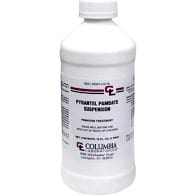This week we will focus on some of the more common intestinal parasites that can affect companion cats and dogs. Today’s post will focus on roundworms.
Please remember that all parasitism can (given the right circumstance) seriously affect cats or dogs of any age, however, puppies and kittens who have weaker immune systems and less energy reserves are often the most severely affected.
Cats and Kittens and Roundworms, Oh My!There are two species of roundworms affecting cats and kittens: Toxocara cati and Toxascaris leonina. Toxocara cati is generally felt to be more harmful to cats but Toxascaris leonina is able to infect both dogs and cats. It is helpful to distinguish their eggs under the microscope so as to know which additional pets are at risk.
Most of the time these worms live in the cat’s intestinal tract and are not visible in feces unless they are dead. A special test of fecal material that is prepared and microscopically examined is needed to detect eggs and confirm an infection.
How Infection Occurs

In cats, there are three ways by which infection with Toxocara cati occurs:
- Consuming infective worm eggs from soil in the environment, which sticks to fur and is then ingested through normal grooming.
- Nursing from an infected mother cat .
- Consuming a prey animal – usually a rodent – that is carrying developing worms.
Note: dogs cannot be infected with Toxocara cati. But they can be infected by Toxascaris leonina and they have their own roundworm called Toxocara canis.
Why Is Infection Bad?
Roundworm infection can have numerous negative effects. It is a common cause of diarrhea and can cause vomiting as well. Sometimes the worms themselves are vomited up, which can be alarming as they can be quite large with females reaching lengths of up to seven inches.
The worms consume the host’s nutrients and can lead to nutritional deficiencies and a classical pot-bellied appearance. Heavy infections can lead to pneumonia as the worms migrate into the respiratory tract and, if there are enough worms, the intestine can actually become obstructed.
Human infection by this parasite can occur. If this happens it can be serious as it affects parts of a person’s eye. It is important to minimize the contamination of the environment with the feces of infected animals. A classical source of infection is a child’s outdoor sandbox, in which outdoor cats may defecate.
Life As A Roundworm
Toxocara cati has one of the most amazing life cycles in the animal kingdom
Step One: The Worm Egg Develops An Embryo
Toxocara eggs are passed in the host’s feces. If a fecal sample is tested, it is possible to detect the eggs and confirm roundworm infection. This embryonic worm requires 2 to 4 weeks to develop before it can infect a new host.
Roundworm eggs can withstand harsh environmental conditions, so they may remain infectious for a long time after their 2-4 week development. Eggs can remain infectious for years.
Fresh feces are NOT infectious.
Step Two: The Worm Enters The Cat
After 2-4 weeks the embryonic egg matures inside the egg into a second stage larva. If ingested orally by a cat or by some other animal, the egg hatches in the host’s intestinal tract and the young worm burrows its way out of the intestinal tract to encyst in the host’s other body tissues.

If the new host is a cat, the life cycle proceeds. If the new host is a member of another species, such as a rodent, the larvae wait encysted until the new host is eaten by a cat and then continue its life cycle.
Step Three: The Young Worm Migrates Through The Cat’s Body
This step is where the larvae are ready to migrate. Some larvae simply migrate to the nearby liver and encyst there. Others move to the mammary gland (see later) but the majority will head for the cat’s lungs and have made it there within three days of entering the cat.
Once they get to the lung, they develop into third stage larvae and burrow into the small airways, ultimately traveling upward towards the host’s throat. A heavy infection can produce a serious pneumonia. When they get to the upper airways, the cat starts coughing. The worms are coughed up into the host’s throat where they are swallowed, thus entering the intestinal tract for the second time in their development.
If the host is a nursing mother, these larvae can migrate to the mammary gland instead of the lung. Kittens can thus be infected by drinking their mother’s milk. Larvae that had encysted in the liver and gone dormant will re-awaken during the host’s pregnancy, continuing their migration just in time to infect the nursing kittens.
When cats are dewormed, this affects only worms in the intestinal tract. It does not affect encysted larvae. It is difficult to prevent mother-to-kitten transmission and routine deworming is not adequate.
Step Four: Worms Mate And Lay Eggs of Their Own!
Once back in the intestine, the larvae complete their maturation and begin to mate. The first eggs are laid about one week after the fourth stage larvae have arrived in the intestine and about four to five weeks after infection has first occurred. From here the cycle repeats.
How Do We Know If Our Cat Is Infected?
You may not know and this is why companion animals should be on regular preventatives. Regular deworming is especially recommended for cats that hunt and might consume the flesh of hosts carrying worm larvae. Kittens are simply assumed to be infected and automatically dewormed at each veterinary visit as they get their kitten vaccinations.
Other ways to know or suspect that your pet is infected are as follows:
- If a cat or kitten vomits up a worm
- If your cat or kitten starts coughing
- If your cat or kitten has a pot-bellied appearance
- If you cat or kitten is losing weight, having diarrhea and/or vomiting
If any of the above are noted, bring your pet to see a veterinarian.
Fecal testing for worm eggs is a must for kittens and a good idea for adult cats having their annual check up. Obviously, if there are worms, they must be laying eggs in order to be detected but, by and large, fecal testing is a reliable method of detection.
How Do We Get Rid Of Roundworms?

Numerous deworming products are effective. Some are over the counter and some are prescription. Many flea control and/or heartworm prevention products provide a monthly deworming, which is especially helpful in minimizing environmental contamination. Common active ingredients include:
- Pyrantel pamoate (active ingredient in Strongid®, Nemex®, Heartgard Plus®, Drontal®, HeartgardPlus® and others)
- Fenbendazole (active ingredient in Panacur®)
There are two important concepts to keep in mind about deworming. Medications essentially anesthetize the worm so that it lets go of its grip on the host’s intestine and it passes out with the stool. Once it has been passed, it cannot survive in the environment and dies. This means that you will likely see the worms when they pass so be prepared; they can be quite long and still be alive and moving when you see them.
The other concept stems from the fact that larvae in migration cannot be killed by most deworming products. After the worms are cleared from the intestine, they will be replaced by new worms completing their migration. This means that a second, and sometimes even a third, deworming is needed to keep the intestine clear. The follow-up deworming is generally given several weeks following the first deworming to allow for migrating worms to arrive in the intestine where they are vulnerable.
Do not forget your follow-up deworming. This second or third round is to get migrating larvae that were not in the intestinal tract at the first deworming.
The Companion Animal Parasite Council recommends that routine deworming of kittens begin at age 2 weeks to prevent hookworm infection and then the kittens should be placed on a monthly heartworm preventive that includes protection/deworming against Toxocara cati.
As with Toxocara cati, diarrhea can result from Toxascaris leonina and deworming is needed to control symptoms and prevent contagion. T
Many of the newer deworming products are not labeled for use against Toxascaris leonina, which does not necessarily mean that they do not work but here are the reliable classics that have been used for decades with efficacy:
- Pyrantel pamoate (active ingredient in Strongid®, Nemex®, Drontal®, Heartgard® and others)
- Fenbendazole (active ingredient in Panacur®)
Deworming summary:
Because Toxocara migrates through the body, a sequence of deworming is typically performed so as to get all the larvae that were migrating at the time of the earlier deworming. Also, once dewormed remeber that a known infection of a worm suggests a contaminated environment, which is why the Companion Animal Parasite Council recommends regular deworming for pet dogs and cats.

